Focus on Wood
Project: PDX Main Terminal Expansion
Location: Portland, Oregon
Architect: ZGF
An airport terminal reaches for the sky with a spectacular mass-timber roof
BY RANDY GRAGG
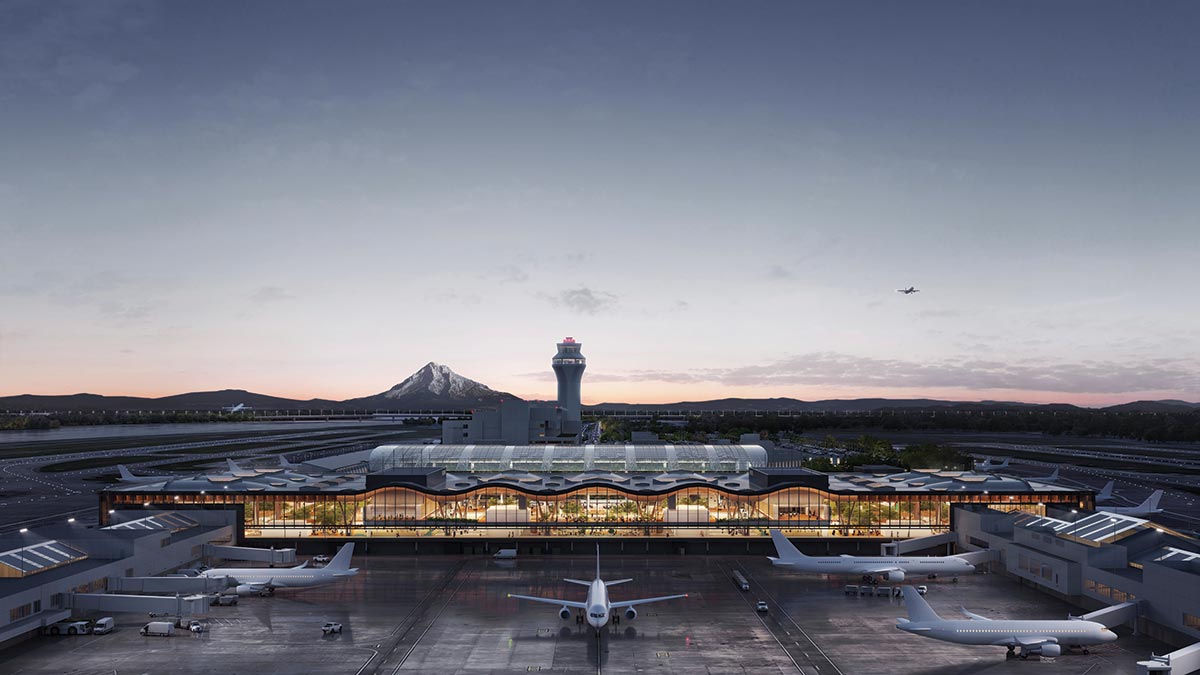
Image © PORT OF PORTLAND/ZGF
The new terminal, with its undulant roof will be twice the size of the one it replaces.
Since the Portland International Airport (PDX) first sprouted 83 years ago next to the Columbia River, its operator, the Port of Portland, has aimed to give travelers a deep sense of the local. Early versions of the main terminal framed nearby Mount Hood with a dynamic entry of western cedars planted in runway-inspired chevron rows. As explosive growth obliterated those features, the Port brought the region indoors with the “Oregon Market”—often described as the first entirely locavore airport shopping experience in the world—offering boutique Oregon wines, eats, and an outpost of the famed Powell’s Books.
Several local architectural firms have stewarded the “sense of place” that routinely nets PDX “top airport” awards, but none more than ZGF, designers of over a dozen expansions and remodels since the 1960s. The latest, a dramatic enlargement and rethinking of PDX’s main terminal, set to open next year, takes the ethos to new heights, architecturally, economically, and, perhaps, even politically.
Constructed by Hoffman Skanska, with KPFF as the structural engineer, the design is inspired by what ZGF partner Gene Sandoval describes as “your first walk in an Oregon forest.” Visitors will arrive at a nine-acre room where a grid of 34 steel columns branch 53 feet upward throu¬gh an undulating lattice “overstory” made of 34,000 lengths of 3-by-6-inch timbers. Rising and falling in a basket-weave of arches and scallops and gently filtering the sun through 46 skylights, the lattice will offer a forest canopy’s calming sense of enclosure. But in three central places, the lattice will vault upward around oval-shaped skylights, opening like a sudden clearing. The entire 400-by-1,000-foot volume will be laced with trees and hanging plants and wrapped by floor-to-ceiling curtain walls of glass, creating a biophilic refuge for watching the busily taxiing planes.
The structure, sourcing, and systems behind the space are equally impressive. The ceiling’s curves are shaped by 1,684 variously flat or arched glulam beams. The roof’s resulting ski-mogul bumps are shaped by a 2-inch-thick mass-timber diaphragm. In all, 3.3 million board feet, entirely Douglas fir, along with the milling and fabrication, were sourced within 250 miles. Doubling the old terminal in size and capacity, this single volume will serve all functions: ticketing, shopping, and airport security, but with a projected 90 percent reduction in fossil fuel use through such features as a radiant-floor system tied to a ground-source heat pump drawing from a sandstone aquifer 500 feet below and 30-foot-tall curtain walls in which the mullions have been designed as an exoskeleton to reduce heat transfer.
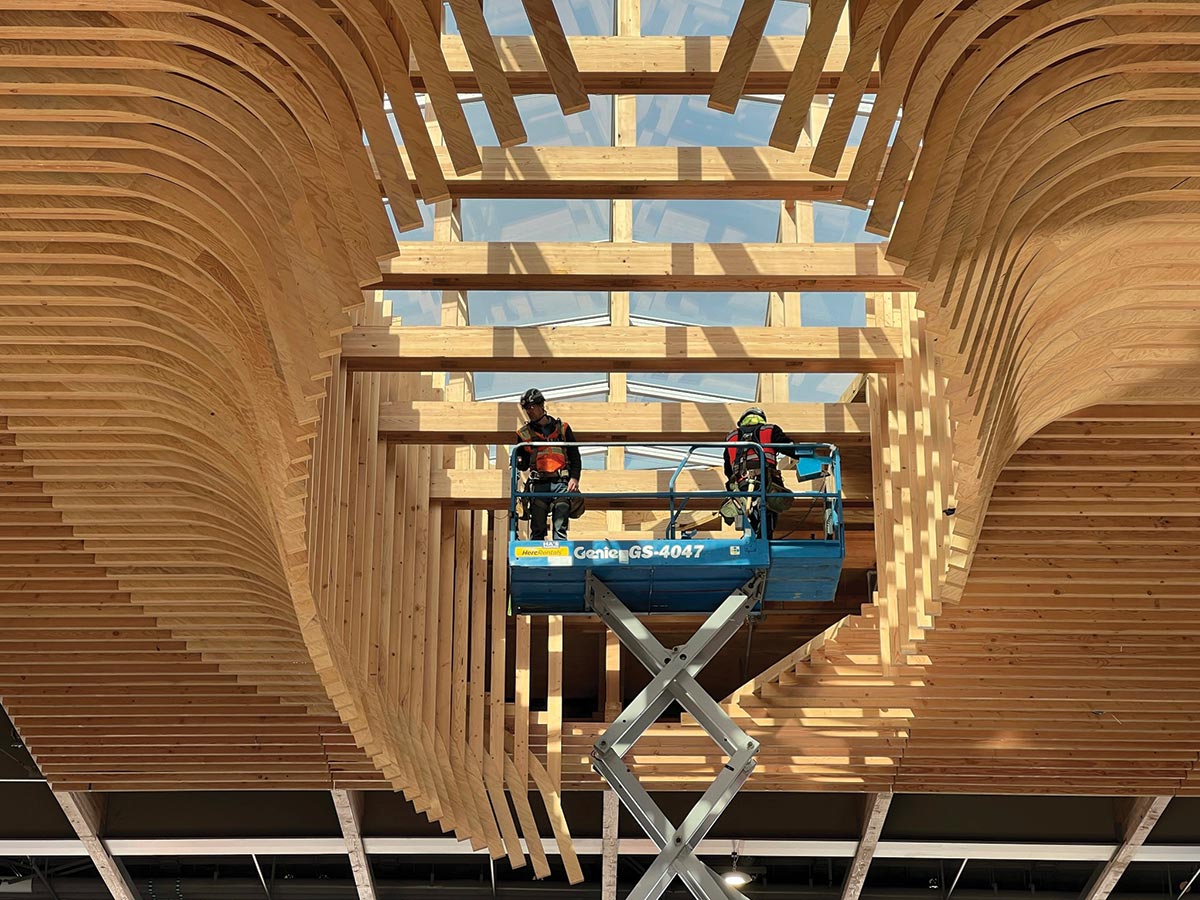
Photo © PORT OF PORTLAND/ZGF
A wood-lattice “overstory” will filter the sun from 46 skylights into the tree- and plant-filled terminal.
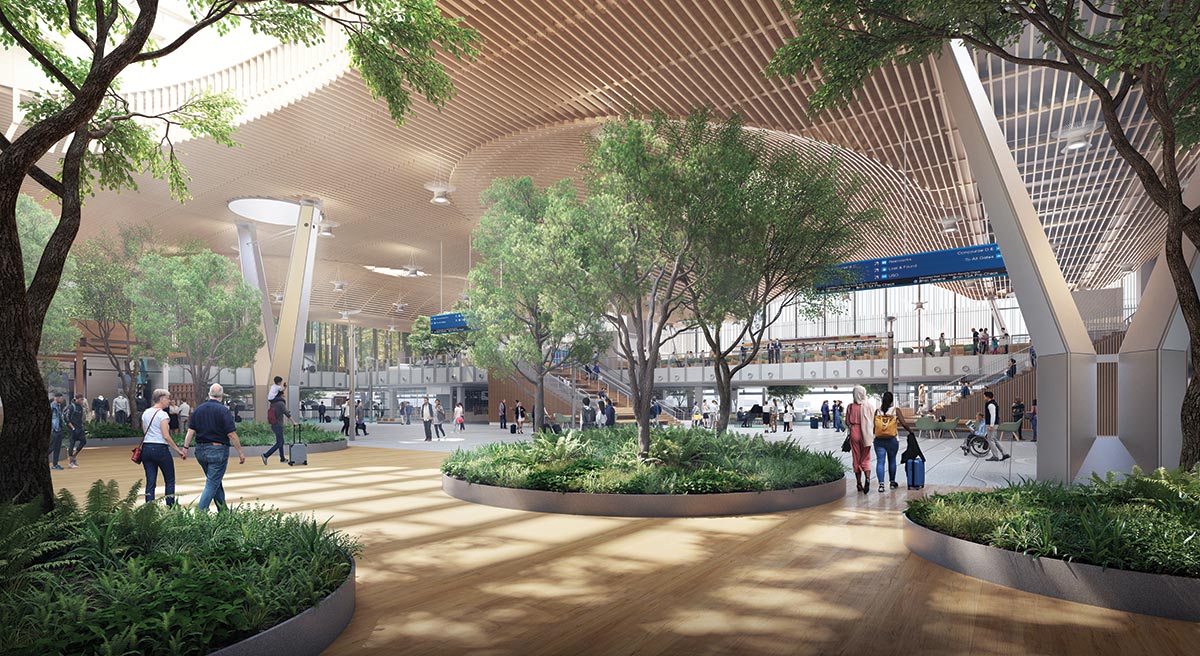
Photo © PORT OF PORTLAND/ZGF
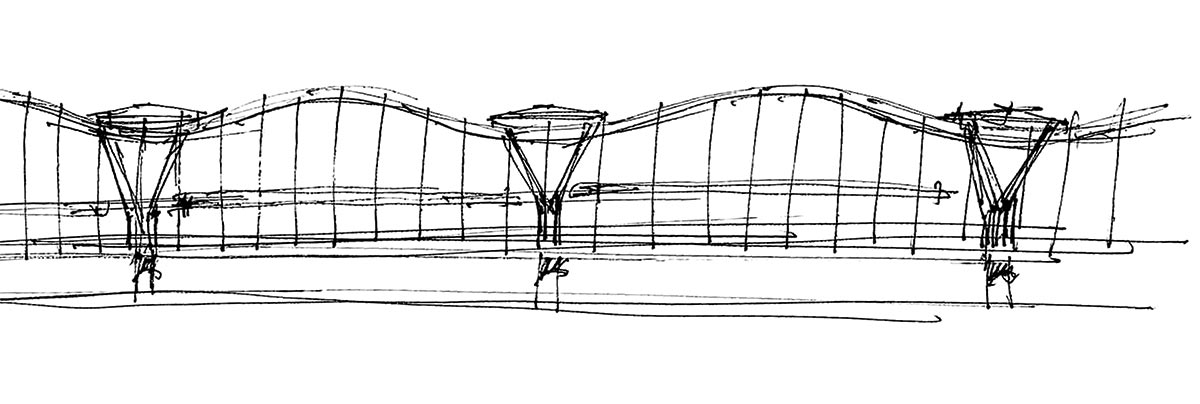
Photo © PORT OF PORTLAND/ZGF
The terminal has been engineered so that when the inevitable 9.0 Cascadian subduction zone earthquake comes, the building will be operational within days. KPFF moved to the top of each column the cups and bearings normally used to isolate the base of a building from the shuddering ground. With the curtain walls hung from perimeter beams, the roof and walls will be able to move up to 22 inches free of the slab and columns. Beyond providing resiliency, the design allowed the steel columns to be narrowed to their thin, tree-like profile.
The stunning architecture leapfrogs a cluster of practical problems. Like virtually every major airport, PDX grew through an agglomeration of additions; the main terminal, alone, is made up of eight separate structures of different eras sitting atop 200 columns, some built of 1950s-era wood—all in the liquefaction-prone soils that filled what once was marshlands. According to Vince Granato, chief projects officer for the Port of Portland, attempting to upgrade the old structure would have triggered dozens of complex, individualized, and costly seismic upgrades. And such a terminal would lack the open spans prized by airlines, and the ability to accommodate the Transportation Security Administration’s (TSA) ever-changing ticketing and security protocols. The new facility, he says, “needed to be flexible enough to adjust to the changes in the passenger journey that we can’t even anticipate today.”
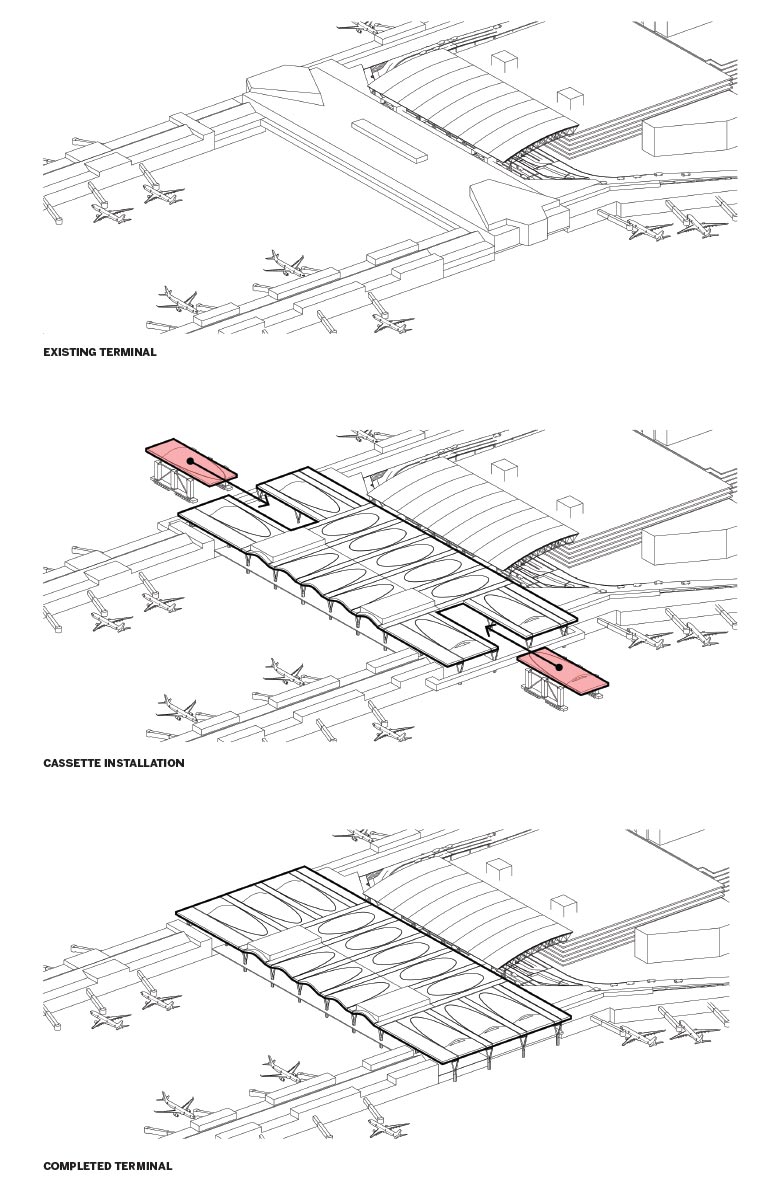
Photo © PORT OF PORTLAND/ZGF
While many airports—among them Denver, Salt Lake City, New Orleans, and Kansas City—solved similar constraints by building anew on greenfield sites, Oregon’s half-century-old agricultural-land protection laws long ago precluded building anew in the grape-rich Willamette Valley. The solution became a phased replacement on the site of the existing terminal. “This land is all we’ve got,” says Granato, “so we’ve had to get creative.”
Construction logistics were a major driver. The new facility had to be built while the old terminal remained operational. Control tower sight lines preclude cranes. Federal Aviation Administration rules forbid nighttime construction except during the four-hour early-morning no-flight window. And any work in the security zone would add measurably to labor costs, with hundreds of workers standing in TSA queues. The team’s response: monster prefab. ZGF and KPFF designed the roof to be built in its entirety—structure, insulation, and utilities—on the ground next to the existing terminal, then “unzipped” into 18 separate “cassettes,” each about 120 by 110 feet. Each piece would then be installed by giant transporters in just three nights: lift, move, and place.
The Port pushed for as much wood as possible, for its lower carbon footprint, to showcase Oregon’s forest-products heritage and continued innovation, and to make the project a regional economic driver (see story, page 138). To achieve the long spans needed for optimal ticketing and TSA security checks, the design required numerous engineering and construction innovations and, Sandoval notes, 160 local building code appeals. Eugene, Oregon’s Zip-O-Laminators, for instance, had never built 80-foot-long glulam beams before, much less ones 9-foot-3-inches deep and bent into 15-foot-6-inch arches. For longer spans, KPFF developed never-before-achieved moment connections between 6-foot-deep steel-and-wood girders. Freres Lumber, a 100-year-old family-owned Oregon company that invented its own mass-plywood panel, had to uniquely shape 1,350 panels, most 11 by 30 feet, many with parabolic curves, to create the undulating roof. The lattice’s basket-like twists and turns required individual puzzle-piece-like cuts, a daunting amount of finish carpentry. ZGF broke the elements down into seven profiles that could be factory fabricated and bar-code labeled to facilitate quick assembly.
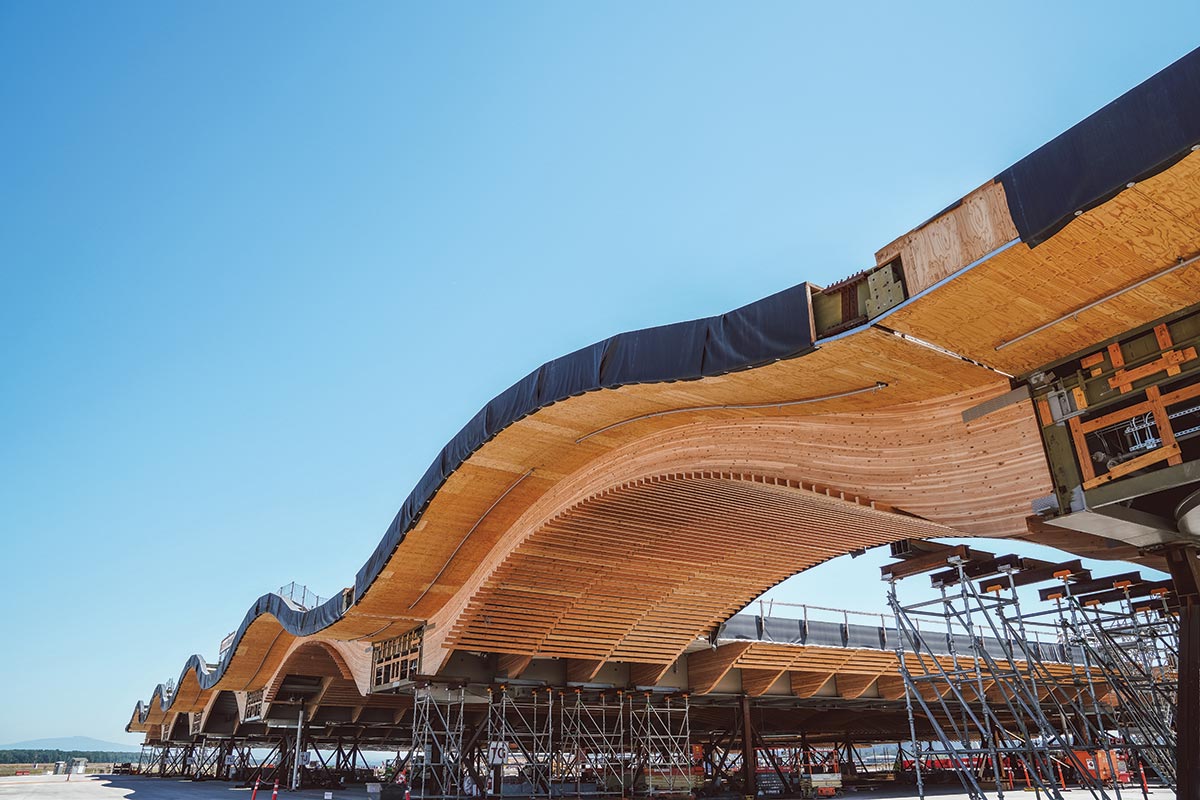
Photo © TIMBERLAB/FLOR PROJECTS
The roof was built in its entirety next to the existing terminal and then installed as “cassettes,” or modules, at night.
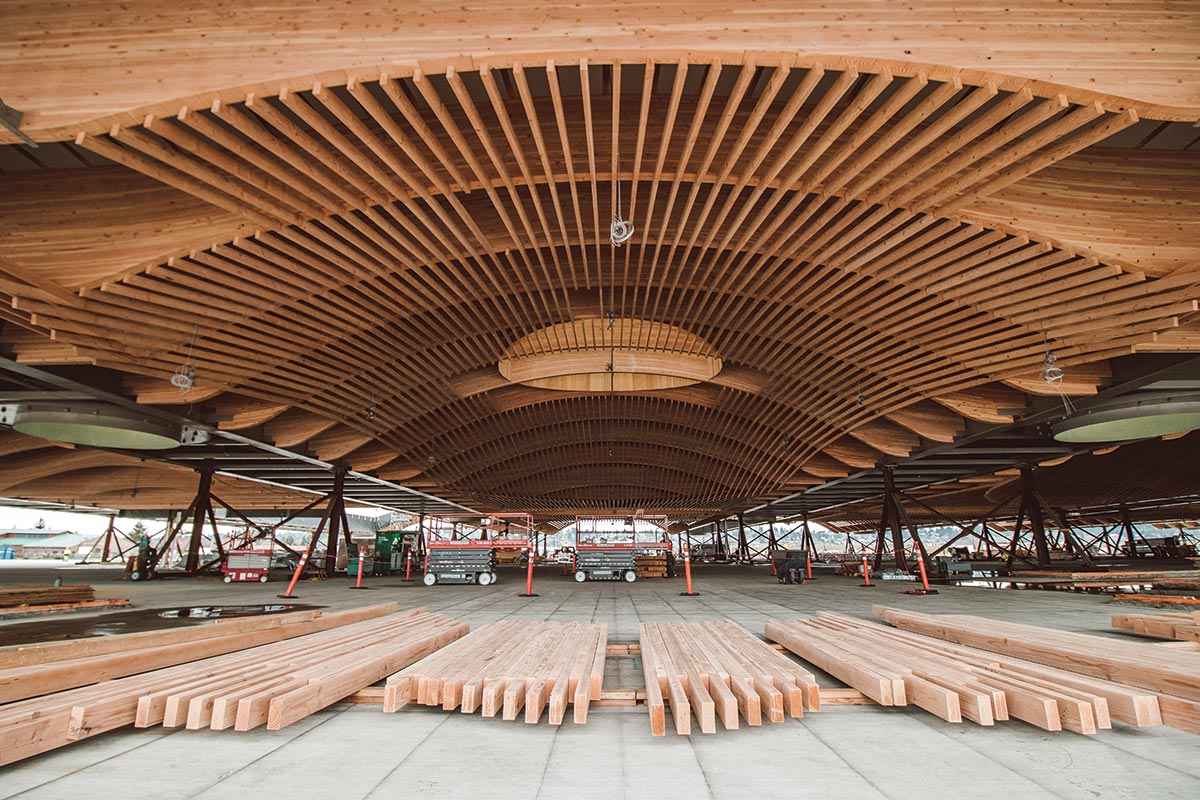
Photo © TIMBERLAB/FLOR PROJECTS
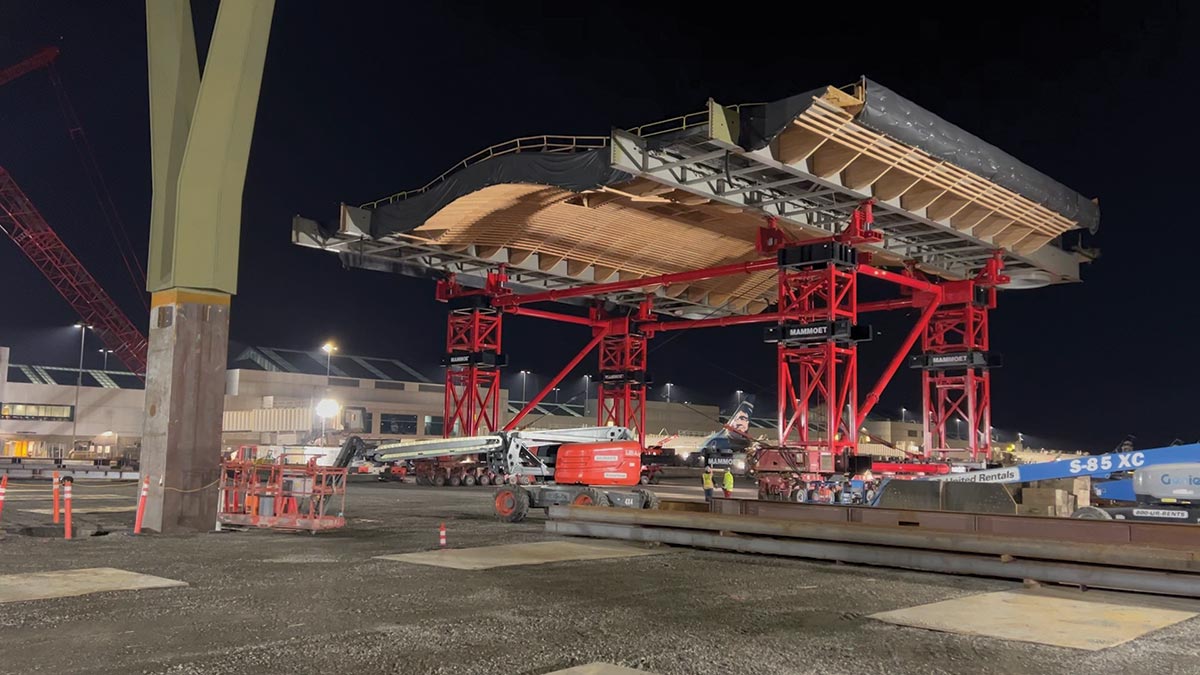
Photo © PORT OF PORTLAND/ZGF
On a March walk-through, 14 of the cassettes were in place. Ten-thousand-pound weights dangled from the perimeter beams, preloading them for the eventual hanging of the curtain walls. But even at 50 percent completion, the overall effect was thrilling, the still-unwoven sections of lattice revealing the many layers of cutting-edge wood structures above.
Sandoval describes the terminal as “maybe the most tectonically pure building we’ve ever done” and contends that the methods pioneered at PDX might solve similar problems faced by the world’s growing number of landlocked airports. But, more locally, he says the team also hopes the Oregon-crafted main terminal can be a stitch between the urban/rural divide, referring to the often politically contentious relationship between major Northwest cities and their surrounding resource-based small towns. “Maybe we can bring everybody together with a building made by many, from scientists to architects and engineers and people who just like working with their hands.”
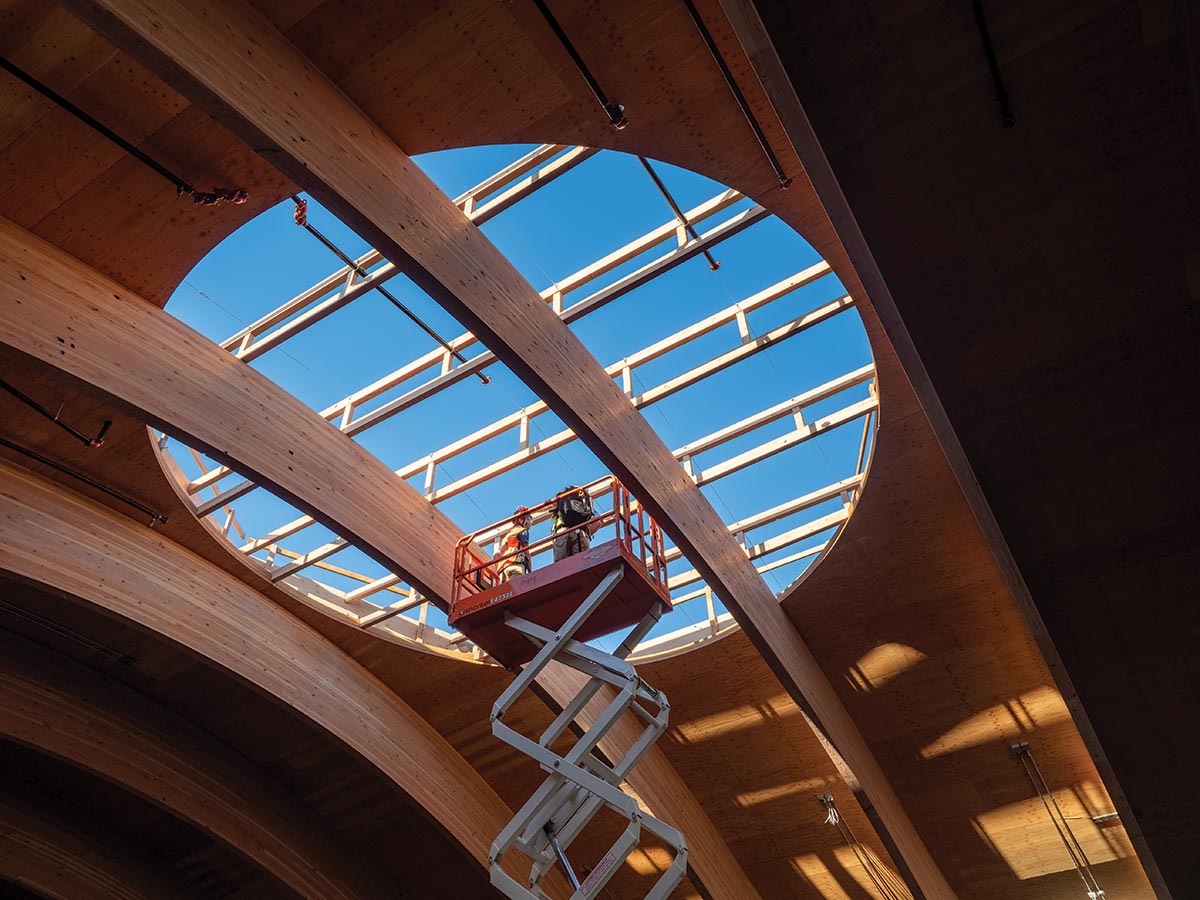
Photo © MIKE BREWINGTON
The arched beams are up to 80 feet long. The in-progress installation of the lattice reveals the many wood layers above.
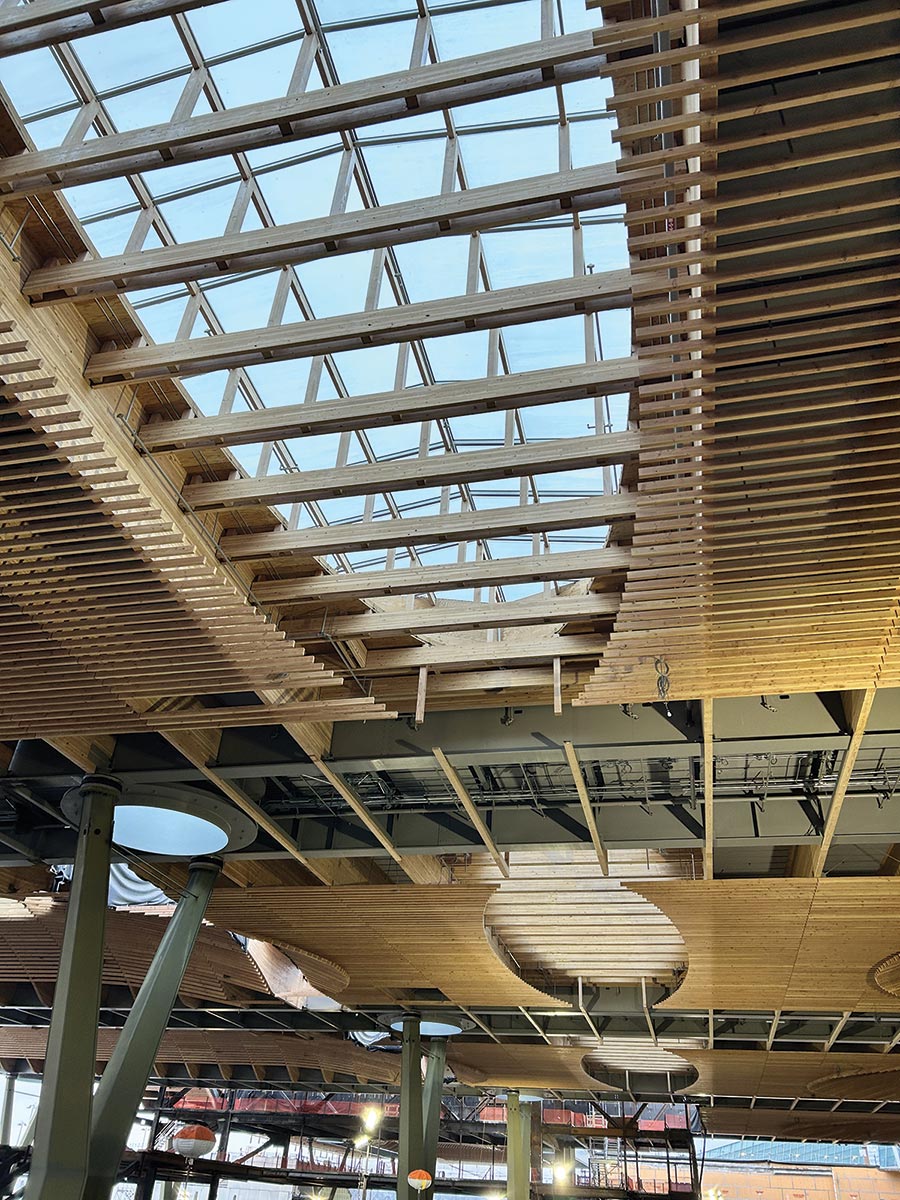
Photo © Freres
Credits
Architect: ZGF Architects
Engineers: KPFF Consulting Engineers (structural); PAE (m/e/p)
Consultants: Swinerton (mass-timber trade partner); W&W AFCO Steel (steel trade partner); Sustainable Northwest, Sustainable Northwest Wood (wood advisors); Arup (aviation planning); Terrapin Bright Green (sustainability)
General Contractor: Hoffman Skanska Joint Venture
client: Port of Portland
Size: 1 million square feet
Cost: $1.79 billion
Completion date: 2025
Sources
Exterior cladding: Morin (metal panels); Henry (moisture barrier); Benson Industries, Arcadia (curtain wall); McKinstry (exterior sunshades)
Mass Timber: Timberlab, Calvert, Freres, Zip-O-Laminators
GLulam connections: Madlyn Metals Fab
Y Columns: Thompson Metal Fab
Skylights: Deamor
Glazing: Carey Glass, Glas Trösch, Viracon
Paints amd stains: Timber Pro
Seismic Isolators: Maurer









